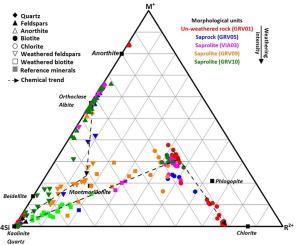Geoderma ( IF 6.1 ) Pub Date : 2022-06-11 , DOI: 10.1016/j.geoderma.2022.115968 M. Bonnet , L. Caner , M. Siitari-Kauppi , A. Mazurier , A.S. Mexias , N. Dani , P. Sardini

|
Weathering transforms fresh un-weathered rock into saprolite and soils, porous materials that may hold available water for plants and nutrients. The conjoint characterization of mineral weathering and development of porosity is helpful in understanding rock weathering and the development of soil.
The objective of this study was to investigate mineralogical transformations and the increase in total porosity during granodiorite weathering in South Brazil by combining petrographical observations, mineralogical analyses, and porosity measurements. The studied granodiorite profile presented a saprock of ∼2 m thickness with spheroidal weathering, a ∼15 m thick saprolite of and soil of ∼2 m thickness. The intensity of weathering was estimated using chemical indices (CIA and WIS) and by the production of fines particles of silt and clay sizes. As weathering increased from saprock to saprolite and soils total porosity increased from 1.73 % in the un-weathered rock, between 3.57 and 10.5 % in the saprock and 11.02 % in the saprolite. The chemical losses were limited in saprock and saprolite (CIA = 68, Δ4Si = 29.31 %) and increased in the topsoil (CIA = 85.73, Δ4Si = 56.83 %), indicating a moderate weathering intensity. Petrographic observations by optical microscope and SEM, chemical composition using SEM-EDS and X-ray diffraction results showed principal mineral weathering reactions were the transformations of biotite into vermiculite (with biotite/vermiculite mixed layers as intermediate weathering stages) and weathering of plagioclases and potassic felspars into kaolinite. The multi-mineral composition of the saprolite indicated a progressive transformation of primary minerals with increasing weathering intensity. The results show that the opening of the porosity is likely to control the development of the weathering and should deserve more detailed characterisation.
中文翻译:

巴西南部 Viamão 花岗闪长岩的风化:第 1 部分 - 粘土矿物的形成和总孔隙度的增加
风化作用将新鲜的未风化岩石转化为腐泥土和土壤,这些多孔材料可以为植物和养分提供可用的水分。矿物风化和孔隙度发育的联合表征有助于理解岩石风化和土壤的发育。
本研究的目的是通过结合岩石学观察、矿物学分析和孔隙度测量来研究巴西南部花岗闪长岩风化过程中的矿物学转变和总孔隙度的增加。所研究的花岗闪长岩剖面呈现出约 2 m 厚的具有球形风化作用的腐泥岩、约 15 m 厚的腐泥土和约 2 m 厚的土壤。风化强度使用化学指数(CIA 和 WIS)以及粉砂和粘土大小的细颗粒的产生来估计。随着从腐泥到腐泥的风化作用增加,土壤总孔隙度从未风化岩石的 1.73% 增加到 3.57% 和 10.5% 之间,在腐泥土中为 11.02%。腐泥土和腐泥土中的化学损失有限(CIA = 68,Δ4Si = 29。31 %) 并在表土中增加 (CIA = 85.73, Δ4Si = 56.83 %), 表明中等风化强度。光学显微镜和 SEM 的岩相观察、SEM-EDS 的化学成分和 X 射线衍射结果表明,主要的矿物风化反应是黑云母转变为蛭石(以黑云母/蛭石混合层为中间风化阶段)和斜长石和钾的风化。长石变成高岭石。腐泥土的多种矿物组成表明,随着风化强度的增加,原生矿物逐渐转变。结果表明,孔隙度的打开可能控制风化的发展,应该得到更详细的表征。光学显微镜和 SEM 的岩相观察、SEM-EDS 的化学成分和 X 射线衍射结果表明,主要的矿物风化反应是黑云母转变为蛭石(以黑云母/蛭石混合层为中间风化阶段)和斜长石和钾的风化。长石变成高岭石。腐泥土的多种矿物组成表明,随着风化强度的增加,原生矿物逐渐转变。结果表明,孔隙度的打开可能控制风化的发展,应该得到更详细的表征。光学显微镜和 SEM 的岩相观察、SEM-EDS 的化学成分和 X 射线衍射结果表明,主要的矿物风化反应是黑云母转变为蛭石(以黑云母/蛭石混合层为中间风化阶段)和斜长石和钾的风化。长石变成高岭石。腐泥土的多种矿物组成表明,随着风化强度的增加,原生矿物逐渐转变。结果表明,孔隙度的打开可能控制风化的发展,应该得到更详细的表征。使用 SEM-EDS 和 X 射线衍射结果的化学成分表明,主要的矿物风化反应是黑云母转化为蛭石(黑云母/蛭石混合层为中间风化阶段)和斜长石和钾长石风化为高岭石。腐泥土的多种矿物组成表明,随着风化强度的增加,原生矿物逐渐转变。结果表明,孔隙度的打开可能控制风化的发展,应该得到更详细的表征。使用 SEM-EDS 和 X 射线衍射结果的化学成分表明,主要的矿物风化反应是黑云母转化为蛭石(黑云母/蛭石混合层为中间风化阶段)和斜长石和钾长石风化为高岭石。腐泥土的多种矿物组成表明,随着风化强度的增加,原生矿物逐渐转变。结果表明,孔隙度的打开可能控制风化的发展,应该得到更详细的表征。腐泥土的多种矿物组成表明,随着风化强度的增加,原生矿物逐渐转变。结果表明,孔隙度的打开可能控制风化的发展,应该得到更详细的表征。腐泥土的多种矿物组成表明,随着风化强度的增加,原生矿物逐渐转变。结果表明,孔隙度的打开可能控制风化的发展,应该得到更详细的表征。



























 京公网安备 11010802027423号
京公网安备 11010802027423号